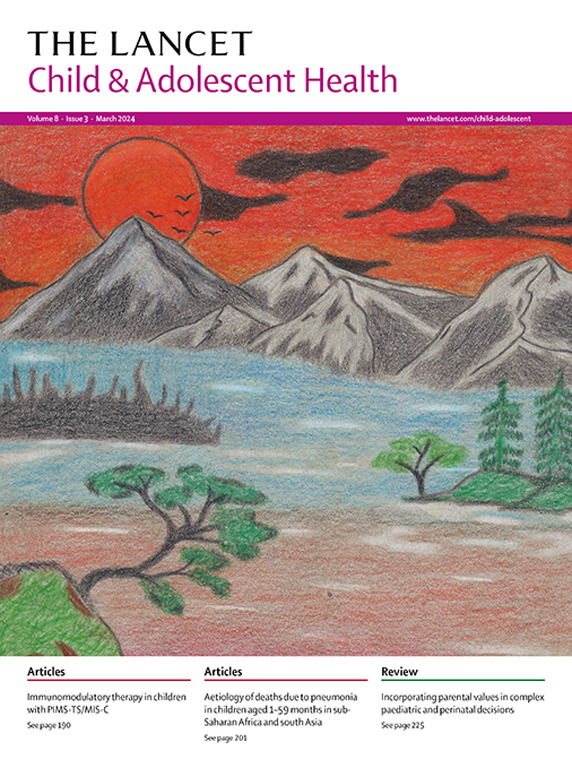Primaquine for uncomplicated Plasmodium vivax malaria in children younger than 15 years: a systematic review and individual patient data meta-analysis
IF 19.9
1区 医学
Q1 PEDIATRICS
引用次数: 0
Abstract
Background
Primaquine, the only widely available treatment to prevent relapsing Plasmodium vivax malaria, is produced as 15 mg tablets, and new paediatric formulations are being developed. To inform the optimal primaquine dosing regimen for children, we aimed to determine the efficacy and safety of different primaquine dose strategies in children younger than 15 years.
Methods
We undertook a systematic review (Jan 1, 2000–July 26, 2024) for P vivax efficacy studies with at least one treatment group that was administered primaquine over multiple days, that enrolled children younger than 15 years, that followed up patients for at least 28 days, and that had data available for inclusion by June 30, 2022. Patients were excluded if they were aged 15 years or older, presented with severe malaria, received adjunctive antimalarials within 14 days of diagnosis, commenced primaquine more than 7 days after starting schizontocidal treatment, had a protocol violation in the original study, or were missing data on age, sex, or primaquine dose. Available individual patient data were collated and standardised. To evaluate efficacy, the risk of recurrent P vivax parasitaemia between days 7 and 180 was assessed by time-to-event analysis for different total mg/kg primaquine doses (low total dose of ∼3·5 mg/kg and high total dose of ∼7 mg/kg). To evaluate tolerability and safety, the following were assessed by daily mg/kg primaquine dose (low daily dose of ∼0·25 mg/kg, intermediate daily dose of ∼0·5 mg/kg, and high daily dose of ∼1 mg/kg): gastrointestinal symptoms (vomiting, anorexia, or diarrhoea) on days 5–7, haemoglobin decrease of at least 25% to less than 7g/dL (severe haemolysis), absolute change in haemoglobin from day 0 to days 2–3 or days 5–7, and any serious adverse events within 28 days. This study is registered with PROSPERO, CRD42021278085.
Findings
In total, 3514 children from 27 studies and 15 countries were included. The cumulative incidence of recurrence by day 180 was 51·4% (95% CI 47·0–55·9) following treatment without primaquine, 16·0% (12·4–20·3) following a low total dose of primaquine, and 10·2% (8·4–12·3) following a high total dose of primaquine. The hazard of recurrent P vivax parasitaemia in children younger than 15 years was reduced following primaquine at low total doses (adjusted hazard ratio [HR] 0·17, 95% CI 0·11–0·25) and high total doses (0·09, 0·07–0·12), compared with no primaquine. In 525 children younger than 5 years, the relative rates of recurrence were also reduced, with an adjusted HR of 0·33 (95% CI 0·18–0·59) for a low total dose and 0·13 (0·08–0·21) for a high total dose of primaquine compared with no primaquine. The rate of recurrence following a high total dose was reduced compared with a low dose in children younger than 15 years (adjusted HR 0·54, 95% CI 0·35–0·85) and children younger than 5 years (0·41, 0·21–0·78). Compared with no primaquine, children treated with any dose of primaquine had a greater risk of gastrointestinal symptoms on days 5–7 after adjustment for confounders, with adjusted risks of 3·9% (95% CI 0–8·6) in children not treated with primaquine, 9·2% (0–18·7) with a low daily dose of primaquine, 6·8% (1·7–12·0) with an intermediate daily dose of primaquine, and 9·6% (4·8–14·3) with a high daily dose of primaquine. In children with 30% or higher glucose-6-phosphate dehydrogenase (G6PD) activity, there were few episodes of severe haemolysis following no primaquine (0·4%, 95% CI 0·1–1·5), a low daily dose (0·0%, 0·0–1·6), an intermediate daily dose (0·5%, 0·1–1·4), or a high daily dose (0·7%, 0·2–1·9). Of 15 possibly drug-related serious adverse events in children, two occurred following a low, four following an intermediate, and nine following a high daily dose of primaquine.
Interpretation
A high total dose of primaquine was highly efficacious in reducing recurrent P vivax parasitaemia in children compared with a low dose, particularly in children younger than 5 years. In children treated with high and intermediate daily primaquine doses compared with low daily doses, there was no increase in gastrointestinal symptoms or haemolysis (in children with 30% or higher G6PD activity), but there were more serious adverse events.
Funding
Medicines for Malaria Venture, Bill & Melinda Gates Foundation, and Australian National Health and Medical Research Council.
治疗 15 岁以下儿童无并发症间日疟原虫疟疾的伯氨喹:系统综述和个体患者数据荟萃分析。
背景:伯氨喹是目前唯一广泛使用的预防复发性间日疟原虫疟疾的治疗药物,其生产规格为15毫克片剂,目前正在开发新的儿科制剂。为了给儿童提供最佳伯氨喹剂量方案,我们旨在确定不同伯氨喹剂量策略对 15 岁以下儿童的疗效和安全性:我们进行了一项系统性回顾(2000 年 1 月 1 日至 2024 年 7 月 26 日),研究对象为至少有一个治疗组的间日喹疗效研究,这些治疗组在多天内服用伯氨喹,入组儿童年龄小于 15 岁,对患者进行了至少 28 天的随访,并且在 2022 年 6 月 30 日之前有数据可供纳入。如果患者年龄在15岁或15岁以上、患有重症疟疾、在确诊后14天内接受过辅助抗疟药物治疗、在开始接受裂殖治疗后7天以上才开始使用伯氨喹、在原始研究中违反了协议、或缺少年龄、性别或伯氨喹剂量数据,则将其排除在外。对现有的患者个人数据进行了整理和标准化。为评估疗效,对不同的伯氨喹总剂量(低总剂量为 3-5 毫克/千克,高总剂量为 7 毫克/千克)进行了时间到事件分析,以评估第 7 天至 180 天期间复发性间日疟原虫寄生虫病的风险。为评估耐受性和安全性,按伯氨喹每日毫克/千克的剂量(低剂量每日毫克/千克∼0-25毫克/千克,中剂量每日毫克/千克∼0-5毫克/千克,高剂量每日毫克/千克∼1毫克/千克)对以下方面进行了评估:第 5-7 天出现胃肠道症状(呕吐、厌食或腹泻)、血红蛋白下降至少 25%至低于 7g/dL(严重溶血)、血红蛋白从第 0 天到第 2-3 天或第 5-7 天的绝对变化,以及 28 天内出现任何严重不良事件。本研究已在 PROSPERO 注册,编号为 CRD42021278085:共纳入了来自 15 个国家、27 项研究的 3514 名儿童。在不使用伯氨喹的情况下,第180天的累计复发率为51-4%(95% CI 47-0-55-9);在使用低剂量伯氨喹的情况下,累计复发率为16-0%(12-4-20-3);在使用高剂量伯氨喹的情况下,累计复发率为10-2%(8-4-12-3)。与不使用伯氨喹相比,使用低剂量伯氨喹(调整后危险比[HR]为0-17,95% CI为0-11-0-25)和高剂量伯氨喹(0-09,0-07-0-12)后,15岁以下儿童复发间日疟原虫血症的危险性降低。在525名5岁以下儿童中,相对复发率也有所降低,与不使用伯氨喹相比,低总剂量伯氨喹的调整危险比为0-33(95% CI 0-18-0-59),高总剂量伯氨喹的调整危险比为0-13(0-08-0-21)。与低剂量相比,总剂量高的伯氨喹可降低15岁以下儿童的复发率(调整后HR为0-54,95% CI为0-35-0-85)和5岁以下儿童的复发率(0-41,0-21-0-78)。与未使用伯氨喹相比,在调整了混杂因素后,使用任何剂量伯氨喹治疗的儿童在第5-7天出现胃肠道症状的风险更大,未使用伯氨喹治疗儿童的调整风险为3-9%(95% CI 0-8-6),伯氨喹日剂量低的儿童为9-2%(0-18-7),伯氨喹日剂量中等的儿童为6-8%(1-7-12-0),伯氨喹日剂量高的儿童为9-6%(4-8-14-3)。在葡萄糖-6-磷酸脱氢酶(G6PD)活性为30%或更高的儿童中,不使用伯氨喹(0-4%,95% CI 0-1-1-5)、每日低剂量(0-0%,0-0-1-6)、每日中等剂量(0-5%,0-1-1-4)或每日高剂量(0-7%,0-2-1-9)时,很少发生严重溶血。在15例可能与药物相关的儿童严重不良事件中,2例发生在低剂量伯氨喹治疗后,4例发生在中剂量伯氨喹治疗后,9例发生在高剂量伯氨喹治疗后:与低剂量相比,高剂量伯氨喹在减少儿童复发性间日疟原虫寄生虫病方面疗效显著,尤其是在5岁以下儿童中。与每日低剂量相比,每日高剂量和中等剂量伯氨喹治疗的儿童胃肠道症状或溶血(在G6PD活性为30%或更高的儿童中)没有增加,但严重不良事件增多:资金来源:疟疾新药研发公司、比尔及梅林达-盖茨基金会、澳大利亚国家健康与医学研究委员会。
本文章由计算机程序翻译,如有差异,请以英文原文为准。
求助全文
约1分钟内获得全文
求助全文
来源期刊

Lancet Child & Adolescent Health
Psychology-Developmental and Educational Psychology
CiteScore
40.90
自引率
0.80%
发文量
381
期刊介绍:
The Lancet Child & Adolescent Health, an independent journal with a global perspective and strong clinical focus, presents influential original research, authoritative reviews, and insightful opinion pieces to promote the health of children from fetal development through young adulthood.
This journal invite submissions that will directly impact clinical practice or child health across the disciplines of general paediatrics, adolescent medicine, or child development, and across all paediatric subspecialties including (but not limited to) allergy and immunology, cardiology, critical care, endocrinology, fetal and neonatal medicine, gastroenterology, haematology, hepatology and nutrition, infectious diseases, neurology, oncology, psychiatry, respiratory medicine, and surgery.
Content includes articles, reviews, viewpoints, clinical pictures, comments, and correspondence, along with series and commissions aimed at driving positive change in clinical practice and health policy in child and adolescent health.
 求助内容:
求助内容: 应助结果提醒方式:
应助结果提醒方式:


